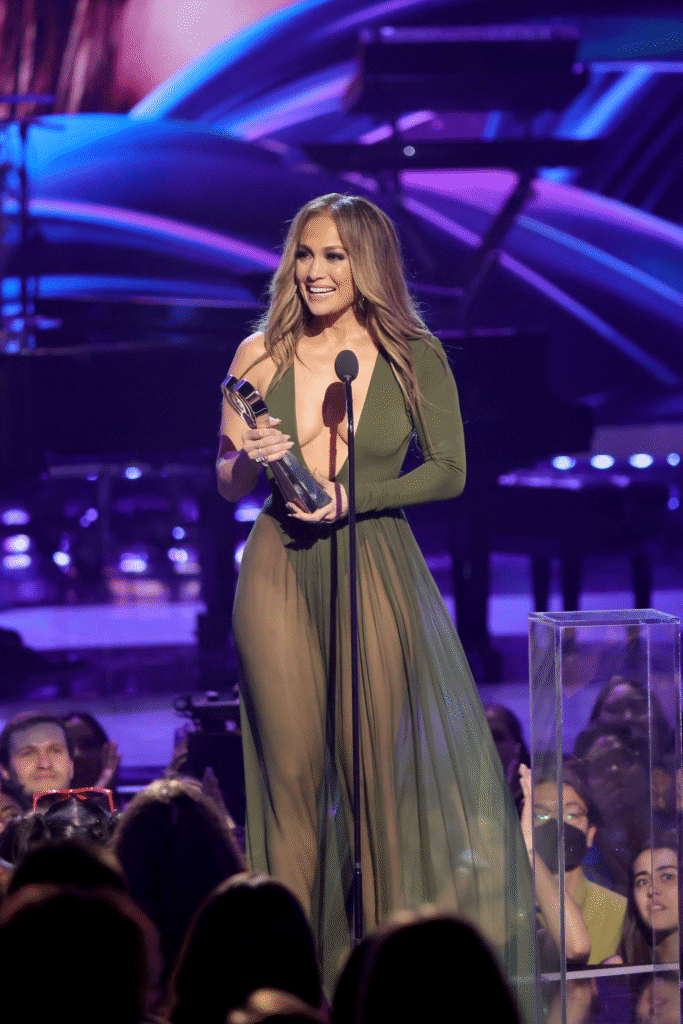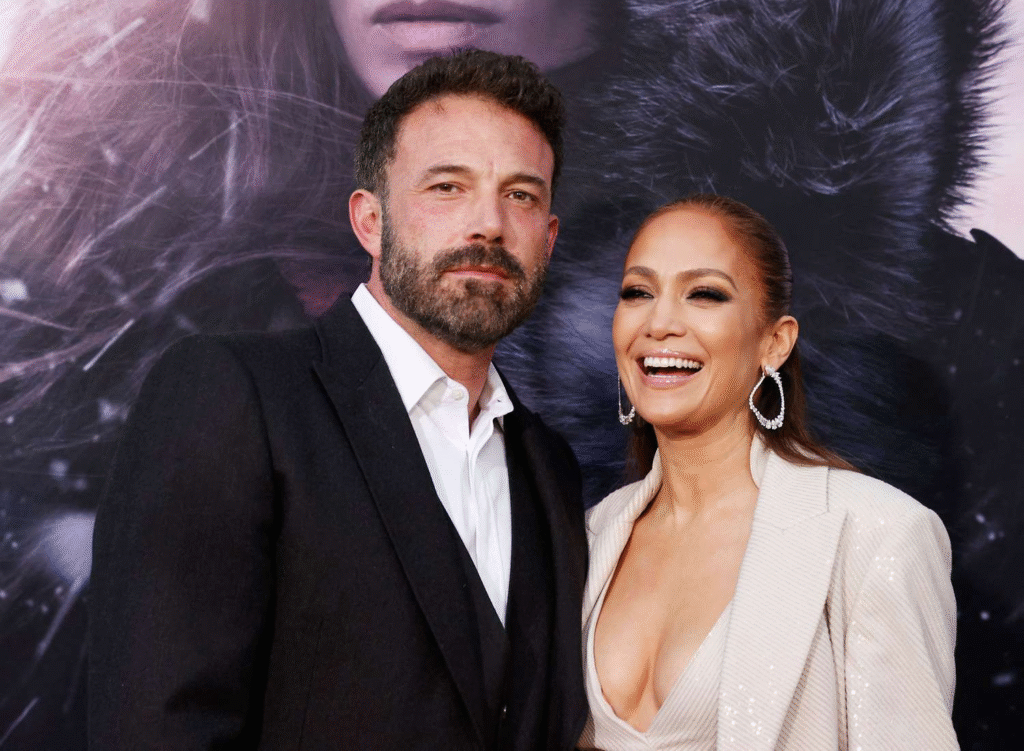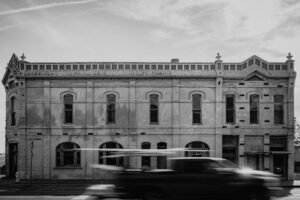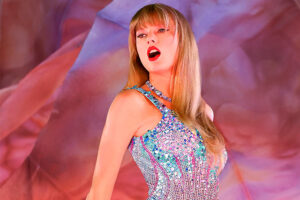Jennifer Lopez’s Billion-Dollar Brand: From J.Lo to Mogul
For over three decades, she has been a constant, luminous…
For over three decades, she has been a constant, luminous presence in the cultural cosmos. She has been a dancer, an actress, a singer, a producer, a fashion icon, and a television personality. But to define her by any one of these titles is to miss the point entirely. To see her as a mere performer is to look at a skyscraper and only see a single window.
The true story of Jennifer Lopez is not just one of talent, ambition, or longevity. It is the story of a master brand architect. It is the narrative of how a girl from the Bronx, armed with an unshakeable work ethic and an intuitive understanding of her own appeal, methodically built a multi-faceted, global empire. This is the story of the transition from “J.Lo,” the pop-culture phenomenon, to Jennifer Lopez, the billion-dollar mogul.
Jennifer Lopez | UP ALL NIGHT REHEARSALS | Ain’t It Funny with Derek Hough
The term “mogul” is often thrown around, but in her case, it is not hyperbole. Her wealth is not merely the accumulated earnings of a successful entertainer. It is the result of a deliberate, strategic, and often brilliant series of business moves that transformed her name into a powerful, bankable, and diversified brand. From revolutionizing the celebrity fragrance industry to building a production powerhouse, launching fashion lines, and creating a beauty empire in her fifties, she has authored a unique playbook for modern stardom.
This is not a story of overnight success. It is a story of grit, reinvention, and an almost preternatural ability to harness synergy, making every project—a film, a song, a red-carpet appearance—a promotional vehicle for every other facet of her enterprise. She didn’t just participate in culture; she monetized it, packaged it, and sold it back to an adoring public that could never get enough.
This is the deconstruction of the J.Lo Blueprint. It’s an analysis of how she codified her unique “glow” into tangible products, leveraged authenticity into a billion-dollar currency, and built an empire brick by brick, all while dancing in heels. This is the story of how Jennifer Lopez became the CEO of herself.
Chapter 1: The Foundation – Forging the “Triple Threat” (The 1990s)
Before the billion-dollar brand, before the fragrances and the fashion lines, there was the foundation. The empire Jennifer Lopez would later build was constructed upon an exceptionally strong and strategically laid foundation in the 1990s: the establishment of her credibility as a true “triple threat.” In an industry that loves to put artists in a box, she systematically broke out of every single one, using each skill to leverage the next.
The Dancer: The Fly Girl with Fire
Her first national introduction was as a “Fly Girl” on the hit sketch comedy show In Living Color in 1991. In a troupe of talented dancers, she stood out. It wasn’t just her technique; it was her intensity, her camera-awareness, her undeniable star quality. Dancing was her entry point, the raw kinetic energy that got her in the door. It taught her discipline, the value of rehearsal, and how to command a stage. This physical expressiveness would become a hallmark of her performance style for decades to come, but she knew from the beginning it was a stepping stone, not a destination.
She transitioned from a backup dancer for artists like Janet Jackson to pursuing acting, a move many saw as a long shot. But this early ambition revealed the first principle of the J.Lo Blueprint: Never stay in your lane.
The Actress: The Breakthrough of Selena
Throughout the mid-90s, she took on a series of supporting roles in films like Money Train and Jack. The turning point, the moment that elevated her from a recognizable face to a bona fide leading lady, was her casting as the lead in the 1997 biopic Selena.
The role was a massive gamble. Portraying the beloved, tragically slain Tejano singer Selena Quintanilla-Pérez was a monumental task, carrying the weight of a grieving community’s expectations. Jennifer Lopez didn’t just play Selena; she inhabited her. She spent time with the Quintanilla family, studied hours of footage, and captured the singer’s infectious warmth, charisma, and on-stage magic.

Her performance was a critical and commercial triumph. It earned her a Golden Globe nomination and, more importantly, it earned her the adoration of a massive Latino audience and proved to Hollywood that she could carry a major film. Selena did three crucial things for her burgeoning brand:
- It established her as a serious, dramatic actress. She was no longer just the dancer who could act; she was an actress, period.
- It cemented her as a powerful Latina icon. By embodying one of the most beloved figures in Latino culture, she became a symbol of pride and representation.
- It gave her the perfect launchpad for a music career. By so convincingly playing a pop star, she made her own transition into music seem not just plausible, but natural and inevitable.
The Singer: The Launch of a Pop Persona
Riding the wave of her Selena success, Jennifer Lopez signed a record deal with Sony Music. In 1999, she released her debut album, On the 6, a title that paid homage to the subway line she took from the Bronx to her dance auditions in Manhattan. This was a strategic move, immediately grounding her burgeoning global stardom in an authentic, “girl from the neighborhood” narrative.
The album was an instant smash. The lead single, “If You Had My Love,” shot to number one on the Billboard Hot 100. The sound was a perfect fusion of pop, R&B, and a touch of Latin influence—commercial, accessible, and perfectly timed for the turn of the millennium.

With the launch of her music career, the “triple threat” foundation was complete. But the genius was in the synergy. Her movie stardom gave her an enormous platform to promote her music. Her music videos, filled with intricate choreography, reminded everyone that she was a world-class dancer. And her new status as a pop star made her an even bigger, more bankable movie star.
By the close of the 1990s, Jennifer Lopez had achieved something rare. She wasn’t just a dancer who acted or a singer who dabbled in film. She had established three distinct, credible, and successful career paths that all fed into and amplified one another. This powerful, synergistic base was the launchpad from which the J.Lo empire would soon blast off. She had the talent; now it was time to build the brand.
Chapter 2: The Birth of a Brand – Codifying the J.Lo Aesthetic (2000-2003)
If the 90s were about building the foundation, the early 2000s were about constructing the skyscraper. This was the era where “Jennifer Lopez,” the talented performer, was masterfully packaged, branded, and transformed into “J.Lo,” a global pop culture phenomenon. This period saw her codify her aesthetic, her sound, and her persona into a powerful and, most importantly, marketable brand.
The Versace Dress: The Moment That Broke the Internet
February 23, 2000. The 42nd Annual Grammy Awards. Jennifer Lopez arrived on the red carpet in a sheer, jungle-print Versace silk chiffon dress with a neckline that plunged well below her navel. It was audacious, stunning, and instantly iconic.
The dress was more than a fashion statement; it was a cultural event. It became the most-searched query in the history of the internet at the time. In a 2015 essay, former Google CEO Eric Schmidt confirmed that the overwhelming number of searches for photos of Lopez in that dress was the direct inspiration for the creation of Google Image Search. Jennifer Lopez literally broke the internet and forced a tech giant to innovate.
This moment cannot be overstated in the history of her brand. It cemented her status as a daring, fearless fashion icon. It demonstrated her power to command global attention with a single image. The “J.Lo” brand was now synonymous with unapologetic glamour, confidence, and a certain brand of bombshell beauty that was both aspirational and, thanks to her famous curves, a departure from the waif-like models of the era.
The J.Lo Album and the Persona: Authenticity Meets Aspiration
In 2001, she released her second album, simply titled J.Lo. The name itself was a declaration—an embrace of the public-given nickname that had become her brand. The album was a monster hit, debuting at number one. In the same week, her film The Wedding Planner also opened at number one at the box office. This made her the first woman in history to have a number one album and a number one film in the same week.

This was the peak of her synergistic power. But the content of the J.Lo brand was just as important as the commercial success. It was built on a brilliant paradox:
- The Aspiration: The music videos for songs like “Love Don’t Cost a Thing” showcased a life of unimaginable luxury—yachts, mansions, designer clothes. This was the high-glamour, Versace-wearing J.Lo.
- The Authenticity: In 2002, she released the remix album J to tha L–O! The Remixes, which featured the iconic track “Jenny from the Block.” The song became her personal anthem. Over a sample of the familiar “South Bronx” beat, she insisted, “Don’t be fooled by the rocks that I got / I’m still, I’m still Jenny from the Block.”
This duality was the secret sauce. She was both the untouchable global superstar and the relatable girl from the neighborhood. It allowed her fans to dream of her glamorous life while also feeling a deep, personal connection to her roots. She wasn’t one or the other; she was both. This paradoxical identity—”I’m real, but you can’t have this”—would become the most enduring and powerful element of her brand.
Glow by J.Lo: The Scent of an Empire
With her brand identity codified and her global fame at its zenith, Jennifer Lopez made her first, and perhaps most significant, leap from entertainer to entrepreneur. In 2002, she launched her debut fragrance, Glow by J.Lo, in partnership with Coty.
The celebrity fragrance market existed, but it was a sleepy, often down-market space. Most were cheap, forgettable scents that felt like afterthoughts. Jennifer Lopez approached it differently. She was deeply involved in the entire process, from the scent profile to the bottle design and the marketing.
The strategy behind Glow was revolutionary:
- The Scent: Instead of a heavy, formal perfume, Glow was designed to smell like clean, fresh-out-of-the-shower skin with subtle floral notes. It was an extension of her “glow” persona—natural, sensual, and clean. The official description was “the scent of skin.”
- The Bottle: The bottle was not a generic design. It was curved, frosted glass, meant to evoke the shape of her own famous body, adorned with a delicate “J.Lo” charm. It was personal and tactile.
- The Marketing: The ad campaign, shot by the legendary photographer Mario Testino, featured a nude, glistening Jennifer Lopez. The tagline was simple: “Fresh. Sexy. Clean.” It was a direct-to-consumer promise of her signature allure.
Glow was an absolute sensation. It shattered sales records, reportedly bringing in over $100 million in its first year alone. Its success completely revitalized the celebrity fragrance category, creating a new, multi-billion-dollar market that everyone from Britney Spears to Beyoncé would soon enter.
But Glow was more than just a successful product. It was proof of concept for the J.Lo Blueprint. It proved that her brand—the aesthetic, the persona, the “glow”—could be distilled, bottled, and sold. It was the moment she transitioned from being a product herself to being the creator of products. The first major brick in the billion-dollar empire had been laid.
Chapter 3: Expansion and Diversification – Building the Empire Brick by Brick (2004-2010)
With the J.Lo brand established and the spectacular success of Glow proving its commercial power, the mid-to-late 2000s were a period of aggressive expansion and diversification for Jennifer Lopez. She began to strategically leverage her brand equity across a wide range of industries, moving from celebrity endorser to business owner and producer. This was the phase where she built out the infrastructure of her empire.
From Fashion Icon to Fashion Designer
Having been established as a global fashion icon, the next logical step was to enter the fashion industry herself. This was a more challenging path, with several iterations and valuable lessons learned.
- JLO by Jennifer Lopez (2001): Launched early in her brand codification, this line was aimed at the mass market, bringing her signature “street glamour” style—tracksuits, hoop earrings, form-fitting silhouettes—to a younger audience. It was commercially successful initially, leveraging the peak of her pop fame.
- Sweetface (2003): This was an attempt to enter the higher-end, contemporary market. It was more ambitious and aimed for a more sophisticated aesthetic. While it had moments of critical praise and was shown at New York Fashion Week, it struggled to find a consistent footing and was eventually discontinued.
Her ventures in fashion taught a crucial lesson: brand extension requires careful alignment with the target market. While her personal style was aspirational, translating that into a successful high-fashion business was a different challenge. However, these experiences provided an invaluable education in manufacturing, distribution, and the relentless cycle of the fashion industry. She would later apply these lessons with much greater success in a partnership model with Kohl’s in 2011, finding a sweet spot in accessible, affordable fashion for the everyday woman.
Nuyorican Productions: The Power of Ownership
Perhaps the most significant and strategic move of this era was the founding of her production company, Nuyorican Productions, in 2001 with her then-manager Benny Medina. The name, like her album On the 6, was a proud nod to her Puerto Rican roots in New York.
This was a paradigm shift. With Nuyorican, she was no longer just an actress for hire, waiting for good roles to come her way. She was now in a position to create them. Ownership meant control—over the narrative, over the casting, over the final product, and, critically, over the intellectual property.
Nuyorican Productions started by developing projects for Lopez herself, like the films El Cantante and Bordertown. But its vision was always broader. The company’s mission was to create content that gave a voice to diverse stories, particularly those from the Latino community.
Over the years, Nuyorican Productions has become a quiet powerhouse, responsible for a slate of successful film and television projects that many people may not even realize are connected to her:
- Television: The company produced the groundbreaking ABC Family/Freeform drama The Fosters (2013-2018), which was celebrated for its depiction of a multi-ethnic, LGBTQ+-led family. It also produced her NBC crime drama Shades of Blue (2016-2018) and the reality competition show World of Dance (2017-2020), where she also served as a judge.
- Film: Nuyorican was a driving force behind the 2019 critically acclaimed hit film Hustlers. The film, which she also starred in, was a massive box office success and earned her some of the best reviews of her career, including a Golden Globe nomination. More recently, it produced her successful action and romantic comedy films for streaming giants like Netflix (The Mother, This Is Me…Now: A Love Story).
The creation of Nuyorican Productions is a cornerstone of her mogul status. It transformed her from talent to a creator and gatekeeper. It provided a steady stream of revenue independent of her personal performance schedule and gave her a platform to shape the culture, not just react to it. This is a core tenet of the J.Lo Blueprint: If the opportunities you want don’t exist, create them yourself.
The Diversified Portfolio
Alongside these major ventures, she continued to build a diversified portfolio. Her fragrance line became a dynasty, with dozens of successful flankers and new scents that have reportedly generated over $2 billion in sales to date. She signed lucrative endorsement deals with brands like L’Oréal and Gillette. She also quietly began to invest in real estate, building a substantial portfolio of luxury properties.
This period was less about the white-hot glare of the “J.Lo” phenomenon and more about the steady, methodical work of building a diversified, resilient business empire. While her music and film careers had their natural ebbs and flows, the businesses she was building provided a stable, growing foundation of wealth and influence.
Chapter 4: The Reinvention – The American Idol Renaissance and the Modern Mogul (2011-Present)
By the end of the 2000s, after two decades in the spotlight, any artist could be forgiven for entering a legacy phase. But Jennifer Lopez was about to embark on one of the most brilliant second acts in modern pop culture history. This was the era of reinvention, where she leveraged a new platform to reintroduce herself to the world, solidifying her status not just as a star, but as a wise, warm, and enduring icon, setting the stage for her biggest ventures yet.
The American Idol Effect: A Strategic Masterstroke
In 2011, Jennifer Lopez joined the judging panel of American Idol. At the time, her career was perceived to be in a cooler phase. The move was seen by some as a step down for a global movie and music star. In reality, it was a strategic masterstroke.
American Idol put her on primetime television, in the living rooms of millions of Americans, twice a week. But more importantly, it allowed her to showcase a new side of her personality. The public was used to the high-glamour, fiercely confident J.Lo. On Idol, they met Jennifer. She was empathetic, constructive in her criticism, and often emotional, even tearing up when sending contestants home.
This did several things for her brand:
- It Humanized Her: She was no longer just the untouchable icon; she was a mentor, a maternal figure. This accessibility made her more beloved than ever.
- It Reinforced Her Expertise: Her critiques demonstrated her deep knowledge of performance, vocals, and stage presence, reminding the public of the two decades of hard work that underpinned her success.
- It Was a Massive Promotional Platform: She used the show to debut new music, like the hit single “On The Floor,” which became one of the best-selling singles of all time. She wore stunning outfits that kept her at the center of fashion conversations.
The Idol effect was profound. It was a massive, season-long marketing campaign that revitalized her entire brand, re-engaged her core audience, and introduced her to a new generation.
Leveraging the New Momentum: Vegas, TV, and the Super Bowl
Riding the massive wave of her Idol-fueled renaissance, she entered one of the most productive periods of her career, solidifying her mogul status through a series of high-profile, high-earning projects.
- The Las Vegas Residency (2016-2018): Her show, Jennifer Lopez: All I Have, was a blockbuster success. It wasn’t just a concert; it was a spectacle showcasing all her talents—singing, dancing, and high-fashion theatrics. The Vegas residency is a modern mogul’s power move, and hers became one of the most successful in the city’s history, grossing over $100 million.
- Continued TV Dominance: She starred in and executive produced the NBC drama Shades of Blue and was the face and executive producer of the dance competition World of Dance, further cementing her role as both top-tier talent and behind-the-scenes power player via Nuyorican Productions.
- The Super Bowl Halftime Show (2020): This was a crowning achievement. At 50 years old, she co-headlined the Super Bowl LIV halftime show with Shakira. Her performance was a breathtaking display of her enduring stamina, star power, and dance prowess. But it was also a powerful cultural statement, featuring her daughter, Emme, in a cage-like structure while singing “Let’s Get Loud” and Lopez unfurling a feathered cape revealing the American and Puerto Rican flags. It was a celebration of her heritage, a political statement, and an unforgettable spectacle watched by over 100 million people. It was a declaration that she was more relevant and powerful than ever.
JLo Beauty: The Culmination of a Lifelong Brand
In January 2021, Jennifer Lopez launched her most personal and potentially most lucrative venture yet: JLo Beauty. This was not another celebrity skincare line; it was the culmination of a brand promise she had been building for over 20 years. The central question she and her brand had been asked for decades was, “How do you get that glow?” JLo Beauty was the answer.
The strategy was flawless:
- The Authentic Premise: The brand is built around “That J.Lo Glow™,” a tagline that is instantly recognizable and intrinsically linked to her. The brand story is rooted in a supposed family secret: olive oil. The “JLo Beauty® Olive Complex” is the proprietary, science-backed version of this story, blending authenticity with clinical credibility.
- The Target Market: Unlike many celebrity lines aimed at teens, JLo Beauty is unapologetically for a mature audience. Its promise is not about looking 20; it’s about looking vibrant, healthy, and powerful at any age. This “ageless” positioning is perfectly aligned with her own public image.
- The Premium Positioning: The products are priced at a premium-masstige level, sold through its own website and high-end retailers like Sephora. The sleek, gold packaging reinforces the luxurious, aspirational quality of the brand.
JLo Beauty is the perfect capstone to her empire. It monetizes her most famous attribute. It is built on a foundation of authenticity that has been cultivated for decades. And it’s a business she wholly owns and controls. It represents the final evolution from J.Lo the performer to Jennifer Lopez the mogul, who has successfully bottled and sold the very essence of her own enduring star power.
Chapter 5: The J.Lo Blueprint Deconstructed – The Core Principles of a Mogul
Jennifer Lopez’s journey from a dancer in the Bronx to a billion-dollar mogul was not accidental. It was the result of a consistent application of a set of core principles—a strategic blueprint that she has followed, consciously or intuitively, throughout her career. Deconstructing this blueprint reveals a masterclass in modern brand-building.
Principle 1: Master the Authenticity Paradox
This is the central pillar of her brand. She has simultaneously cultivated two seemingly contradictory identities: the glamorous, untouchable global superstar and the relatable, hardworking “Jenny from the Block.” She is dripping in diamonds on the red carpet one moment and talking about her humble Bronx upbringing the next. This paradox is not a contradiction; it is a carefully balanced duality. The glamour makes her aspirational, while the “realness” makes her beloved. It allows her to sell both multi-million dollar movie tickets and an affordable-luxury face serum. She has proven that an audience doesn’t need you to be one thing; they just need you to be consistently and authentically you, in all your complex facets.
Principle 2: Unyielding Work Ethic as a Brand Attribute
The stories of Jennifer Lopez’s legendary work ethic are not just anecdotes; they are a core part of her brand’s marketing. She is famous for being the “first to arrive, last to leave.” She rehearses relentlessly. At an age when many performers slow down, she delivered one of the most physically demanding Super Bowl performances in history. This narrative of hard work does two things: it earns her respect and it makes her success feel earned, not just lucky. It sends a powerful message to her fans: “You can achieve this too, if you’re willing to work for it.” This work ethic is the engine of her empire, but it is also one of its most valuable public-facing assets.
Principle 3: Engineer Strategic Synergy
Nothing in the Lopez empire exists in a vacuum. Every project is a commercial for every other project. This is the “flywheel” effect in action.
- She wears a stunning outfit to a movie premiere, which keeps her in the fashion press and reinforces her status as a style icon, which helps sell her clothing and accessories lines.
- She releases a song for a movie she’s starring in (This Is Me…Now is the ultimate example), so the film promotes the album and the album promotes the film.
- She uses a TV appearance on a show like The Today Show to talk about her new movie, her new album, and her skincare routine using JLo Beauty products.
She understands that every moment in the public eye is an opportunity to cross-promote the different verticals of her business. This creates a powerful, self-sustaining ecosystem where the whole is always greater than the sum of its parts.
Principle 4: Embrace the Power of Reinvention
A career spanning over 30 years is impossible without reinvention. Jennifer Lopez is a master of the pivot. When her film career cooled in the late 2000s, she didn’t fade away; she reinvented herself as a beloved mentor on American Idol. When the music landscape changed, she didn’t chase trends; she established a dominant Las Vegas residency that celebrated her entire catalogue. When she turned 50, she didn’t shy away from it; she made it a central part of her brand, launching an “ageless” beauty company and delivering a career-defining Super Bowl performance. She understands that staying relevant means knowing when to change the conversation and reintroduce yourself to the public on your own terms.
Principle 5: Demand Ownership and Control
This is the ultimate principle that separates the star from the mogul. Early in her career, she recognized the power of ownership. The founding of Nuyorican Productions was the key move. By becoming a producer, she gained control over her creative destiny and, more importantly, her financial future. She moved from being an employee of the Hollywood system to being a boss. This extends to all her major ventures. She didn’t just endorse a fragrance; she partnered to create a fragrance empire. She didn’t just become the “face” of a skincare brand; she launched her own. Ownership means she controls the vision, the profits, and the legacy.
Conclusion: The Billion-Dollar Legacy
The story of Jennifer Lopez is a testament to the power of a singular vision executed with relentless discipline over the course of a lifetime. She is a cultural force, a representation of the American Dream, and a symbol of Latina excellence. But her most enduring legacy may well be the business empire she has built.
She took the raw materials of talent, beauty, and charisma and, like a master alchemist, transformed them into a diversified, billion-dollar portfolio. The J.Lo Blueprint she created has become the new gold standard for celebrity entrepreneurship. It’s a model built on an authentic personal brand, a synergistic business structure, and an unwavering belief in the value of one’s own work.
From the Fly Girl who dreamed of stardom to the global mogul who commands boardrooms, Jennifer Lopez has never stopped working, never stopped pushing, and never stopped building. The “glow” that her beauty brand promises is the same glow that has illuminated her entire career—an inner fire, an unyielding drive, and the brilliant shine of an empire built to last. She is not just Jenny from the Block anymore. She is Jennifer Lopez, the architect of her own destiny, and the CEO of a world she created.





